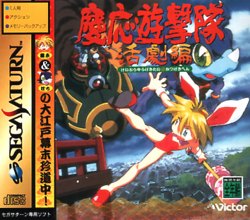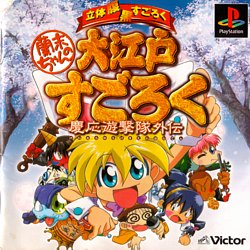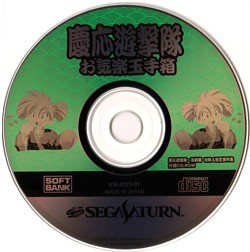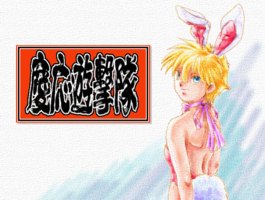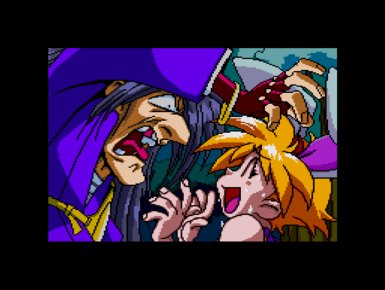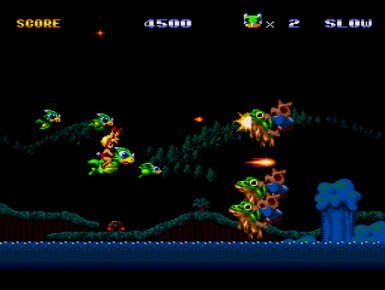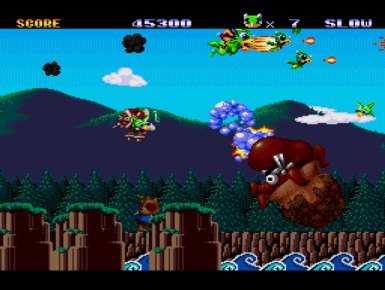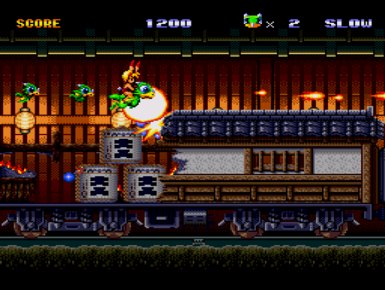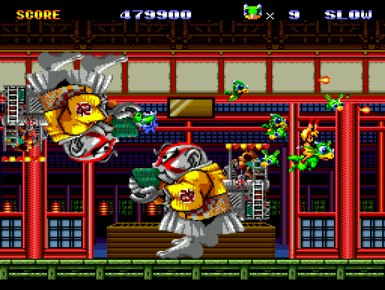|
As many avid gamers know, the Sega CD is home to a lot of those "FMV" games that were so popular in the early to mid nineties. A lot of systems like 3DO, Philips CD-i and others used the CD-based media to add unnecessary cutscenes to a lot of games or make "interactive" movie games (most of which consisted of pushing a button or direction with split-second timing) instead of using the media for more practical gaming purposes, like making more expansive, more impressive games. If Sega had taken notes on what made the Turbo CD such a success (in Japanese territories), maybe Sega CD could have had a much better lifespan. Thankfully, not all developers put their stocks purely in the movie capabilities of the Sega CD. Amidst the horrid FMV games and lazy Genesis-to-SCD ports lie a few original, not entirely crappy games. One such game is Keio Flying Squadron.
In the eighth year of the Keio era, Japan neared the end of its feudal period. The Shogunate, which was facing an uprising by the anti-government movement, asked France for military assistance. However, the French were unwilling to assist, so Japan had turned to the American delegation that was visiting Japan at the time to negotiate the Japan-U.S. peace treaty. The reason for this is because America had established a unique scientific technology that combined Native Indian shamanism with alchemy from Europe to create weapons of incredible power. Sometime during these proceedings, you begin your quest as Rami Nanahikari...A bossy girl sporting the complete "bunny girl" ensemble that includes fiery red (and sometimes shown as violet) pumps, a bowtie, bunny ears, and a bunny tail. Rami also happens to be a descendant of aliens who came to Earth in ancient times. While the historical elements of the opening story sound interesting enough, you will quickly realize that it's not as serious as it's cracked up to be.
An evil 3,000 year old raccoon with an I.Q. of 1,400 named Dr. Pon steals an ancient key known as "Ark" from Rami and her grandmother (whom Rami lives with), who were told to guard it from thieves. While the grandmother fought valiantly, Rami was completely oblivious as to what was happening since she selfishly left to eat a snack. Furious at Rami's foolishness, she kicks Rami out of the house to go after Dr. Pon and won't let her eat any food until she can recover the stolen Ark! As you can guess, a girl has to eat...so Rami reluctantly goes to pursue Dr. Pon after kicking her vegetarian pet dragon, Spot, into high gear.
I'll be frank; Keio Flying Squadron (aka Keio Yugekitai) is a relatively average game. Despite this, the game was received with warm reception from the media and spawned a couple of follow-up titles including a Sega Saturn sequel and a Playstation gaiden/sidestory (which was a board game), not to mention several promotional goodies. Keio was even popular enough to have visual novels and HENTAI made in its honor. After all, it isn't everyday that you play with a dragonrider donning a sexy red tutu who could pass for one of Hugh Hefner's Bunny Playmates. However, before she could pose as a Playboy Bunny, you have to wonder her age, and it's quite a mystery. While she is roughly 13 or 14 in Japan, she is said to be 18 in Europe/Australia and she is 20 in the U.S. (contrary to popular belief). This is because her attire was deemed inappropriate for a young girl. Due to her age increase in the U.S., she could seem more like a "Mather Figure" (as the game's bad U.S. translation states) to her pet dragon, Spot (Pochi in Japan and sometimes called Poti), who is another mystery entirely.
Going back to the game details, the graphics are incredibly plain, and while the case boasts about pure Japanese animation, the game's animated cutscenes have about as much fluidity as Voltron, give or take. It's not terrible, but it's plainly obvious that this game doesn't try too hard to impress, though the FMVs have some charm thanks to famed Japanese animation company, Studio Pierrot, handling the animation (a fact most don't know). The enemies aren't particularly detailed, and most of the backdrops are sparse, not to mention the game slows down occasionally. The anime stills however, are pretty nice and perhaps above the norm in terms of Sega CD quality, though they clearly don't take complete advantage of the hardware. The main draw for this game visually is the strange cast of characters that while nothing out-of-the-ordinary in Japan, stick out like a sore thumb in other parts of the world.
So what about the gameplay then? It's the same old story. The game is comprised of seven short stages filled with enemies with mostly predictable attack patterns. I'll give the game some credit however, as some of the stages can be a little tricky. You don't know when an enemy might fall from the sky or come from behind you without a little practice. Then you have the power-ups, which are even more unimpressive. You have a choice between two standard shots that can be upgraded several levels...a straight shot that is powerful and a spread shot for picking off groups of weaker enemies. You really don't need the spread shot too much though.
You also have a choice of three sub-weapons...a bomb that is meant for ground enemies. You also get a spike bomb with a strange targeting system that shoots in the opposite direction you moved in (Ex: Move left, shoot right). The last power-up is a "Homing Spot", which is just that; You shoot miniature dragons that kamikaze into foes. Then you have a "super bomb"...what mundane shooter doesn't have one of those, right? The interesting thing about super bombs in KFS is that you can restock them by waiting a second or two when you're not shooting. They can really get you out of a bind. Still, I never really use anything other than the homing shot...because you really don't NEED to use anything other than the homing shot.
Still, Keio does have it's good points: First of all, it has a nice soundtrack and good audio. All the tunes have a distinct Japanese feel and the game at least takes advantage of the CD-based media in this regard. All the characters sound funny, and I like Rami's bossy personality and whimsical ways as she tries to put on airs around poor Spot Nanahikari. Dr. Pon kinda sounds like a guy with an I.Q. of 1,400 too...like a major geek, but it just adds to his humorous ways. This brings us to another highlight: Keio's story. It's silly and doesn't make a whole lot of sense, but it's not everyday you find a shooter with a story to tell.
To sum Keio Flying Squadron up, Keio is slightly above average and this game would make for a decent time waster if it was cheap and easy to acquire, but it is sadly quite the opposite. Keio Flying Squadron is one of the rarest North American Sega CD releases and can cost quite a pretty penny at times. Under the current circumstances, I would never buy Keio for that price just to play it. Me and Vyse only have it in the first place because we bought it long ago for a dollar not really knowing WHAT to expect. It might be one of the few Sega CD shooters, but that doesn't mean that it's a great game. A lot of plain old Genesis shooters made years prior are far more impressive in most respects and can easily be had for twenty dollars or less in most cases...Fireshark, Thunder Force, M.U.S.H.A., Gaiares...the list goes on and on, so you should probably pick up one of those instead. - Written by Bel Cain The Eternal - |

